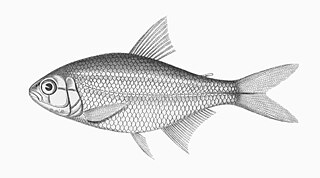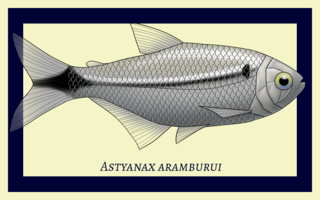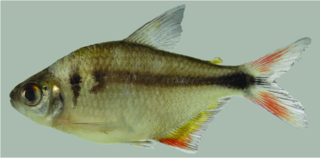
Astyanax is a genus of freshwater fish in the family Characidae of the order Characiformes. Some of these fish, like many of their relatives, are kept as aquarium pets and known collectively as tetras. With around 150 described species and new ones being described yearly, this genus is among the largest of the entire order; Hyphessobrycon also has more than 145 species and which one is larger at any one time depends on whether more species have been recently described in one or the other. The blind and colorless cave tetra of Mexico is a famous member of the genus, but its taxonomic position is disputed: Some recognize it as part of the Mexican tetra and this is supported by phylogenetic evidence, but others recognize the cave form as a separate species, A. jordani.

Ectrepopterus uruguayensis is a small species of characin originally recorded only from streams in Uruguay, with occasional sightings in Brazil and Argentina. It is the only known member of the genus Ectrepopterus, which was formerly a subgenus of Megalamphodus. Given its restricted range, it is considered a rare fish, and is of note for conservation researchers interested in preserving the biodiversity of the region.
Astyanax microschemos is a species of characid fish from Brazil. It belongs to the A. scabripinnis species complex and differs from other species outside it by having a lower number of branched anal fin rays and its shallow body depth being about 26.9-29.7 vs more than 35% of its standard length (SL). Compared to species of its own complex, it can be distinguished by the combination of its shallow body depth, and smaller interorbital width. The species name comes from the Greek mikroschemos, meaning "low stature", which refers to the shallow body depth of the animal.

Deuterodon pelecus is a species of characid fish from Brazil. It can be distinguished from other species by: its body depth ; its short and pointed snout smaller than the orbital diameter; and a reduced number of branched anal fin rays. D. pelecus also differs from members of its genus by its characteristic color pattern. It possesses a single humeral spot that is constricted to the region above the lateral line; at the same time it shows a conspicuous midlateral body stripe from opercle to the caudal fin base, an autapomorphy of this precise species. Other Deuterodon species have a humeral spot that is vertically or horizontally elongate and have the midlateral stripe becoming faint near that humeral spot. The species name is derived from the Greek pelekus, meaning "axe", referring to the pigmentation shape resulting from the adjoinment of the humeral spot with the midlateral stripe.

Carlastyanax aurocaudatus is a small species of freshwater fish in the family Characidae native to the Río Cauca in Colombia. It is the only member of the monotypic genus Carlastyanax, which was named in 1972 specifically for the species by Jacques Géry. Upon description, it was named Astyanax aurocaudatus by Carl H. Eigenmann. There has been debate concerning whether or not the genus should be recognized, but C. aurocaudatus is currently considered a valid species.

Astyanax argentatus is a small freshwater fish native to northern Central America and southern North America. Given its native range, it is also known as the Texan tetra. Little has been published regarding the feeding habits or behavior of A. argentatus, but it is known to have the northernmost distribution of any member of the genus Astyanax.
Bryconops munduruku is a small freshwater fish of the family Iguanodectidae that lives in the rivers of South America. Its adipose fin is black, with a clear base, and it has two humeral spots, which is a feature it shares with few congeners. Its fins are a variety of yellow, red, black, and clear, and mature males have hooks on select fin-rays.

Astyanax abramis is a small freshwater fish from the inland rivers of South America. It is plentiful in almost the entire continent, with a habitat including the La Plata, upper Amazon, and Meta River basins. The body shape is subrhomboidal and laterally compressed, and the scales are largely silver, with a blue or green tint on the dorsal side.

Astyanax angustifrons, sometimes referred to as the Campeche tetra, is a small freshwater fish from the rivers of Central and South America. It has a healthy distribution across southern Mexico and northern Guatemala, and is relatively common within its native range. Details regarding its diet and behavior are sparse, but it lives in areas with plentiful riparian vegetation, and most other members of the genus are omnivorous. Its habitat includes places affected by pollution and human activity; nonetheless, it is not endangered.

Astyanax aramburui is a small freshwater fish from the rivers of South America, restricted to a relatively small region within the Paraná and Uruguay river basins of Argentina. It was named after the scientist who established a professional presence for ichthyology in the country, Raúl Arámburu. Considered a near-threatened species by the IUCN, its range includes creeks in a sub-basin affected by various forms of pollution.

Astyanax argyrimarginatus is a small species of freshwater fish native to various river basins in Brazil. Originally thought to be restricted to the Tocantins-Araguaia river system, a study in 2012 expanded its range to include the Rio Xingu, as well. Specific biotope preferences are unknown, but it is mostly collected from clearwater streams in fairly good health. Its relative abundance and presence in some protected locales means that it is not endangered.

Astyanax asuncionensis is a small species of freshwater fish described in 1972 from Asunción, the capital of Paraguay in South America. Its specific epithet is in reference to this. Currently, its range is known to encompass areas of not just Paraguay but also Argentina and Brazil. It is an adaptable, omnivorous species that easily lives in sympatry with various congeners.

Astyanax bacalarensis, sometimes referred to as the Bacalar tetra, is a small species of freshwater fish found in Central and South America. Its scientific and common names both refer to its type locality, Lake Bacalar in Mexico, and it further inhabits freshwater environments like cenotes, streams, and wetlands. Its widespread nature, paired with an omnivorous diet, make it a hardy species.

Astyanax bagual is a small species of freshwater fish known only from the Taquari-Antas river basin in southern Brazil. It is unusual in the genus Astyanax because mature male specimens display bony hooks on the rays of all fins; in opposition, most others have them on the anal, pelvic, or pectoral fins - sometimes on more than one of these, but very rarely on all fins. It can further be told apart from various congeners by way of dentition and some aspects of coloration, including the presence of two humeral spots instead of one.

Astyanax biotae is a small species of freshwater fish native to various localities in Brazil. It primarily eats invertebrates, like copepods and aquatic fly larvae, and its diet also includes seeds, fruits, and filamentous algae. Its scales are largely silver, with a touch of yellow-brown on the back and a hint of blue on the sides. Like many species of Astyanax, it has a humeral spot, which is a blotch of pigmentation in the area above or around the pectoral fin.

Astyanax bourgeti is a small species of freshwater fish native to the upper Amazon river in Brazil. Originally described in 1908, it is not a particularly well-studied member of the genus Astyanax, but there is enough information available to establish a native range, an appearance, and potential relationships to congeners; for example, A. bourgeti is a known member of the subgenus Poecilurichthys, and has been considered such for most of its existence. Biotope preferences, sympatry, diet, and behavior are all unknown.

Astyanax brevirhinus is a small species of freshwater fish known only from a river basin in northeastern Brazil. It is somewhat understudied and lacks a conservation status, but it is present in a region that is the subject of an ecological restoration project - the Jequitinhonha River. Specifics of diet and behavior are unknown, though shoaling activity has been observed in laboratory conditions.
Astyanax apiaka is a small freshwater fish endemic to the Apiacá river in Mato Grosso, Brazil. Its discovery is recent, as of 2023, which results in little published research of its natural behaviors or preferred biotopes. However, descriptions of its appearance and general environment have been solidified, as well as some baseline information regarding its diet. It lacks a conservation status from the IUCN.

Astyanax clavitaeniatus is a small species of freshwater fish native to various rivers in the Amazon basin. It is characterized by a club-shaped lateral stripe, which is where it gets its scientific name; "clava" means "club", and "taenia" means "stripe". It is a deep-bodied fish with a silvery base color, which is not uncommon for members of Astyanax. Its markings - including a humeral spot and two vertical brown bars - indicate that it is a part of a species complex centered around congener Astyanax bimaculatus.
Astyanax anai is a small freshwater fish native to Central America. It has a restricted range, inhabiting a handful of Atlantic drainages in Costa Rica and Panama, and is known from locales only up to 100 meters elevation. As an endangered species, A. anai is a point of interest for conservation biologists studying the region. It can be found living sympatrically with other species of Astyanax, but is less common than its relatives.

















